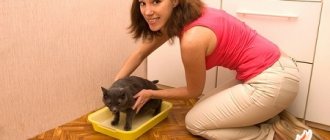The main advantage of every respectable cat is the ability to use a litter box. If the animal does not do this and allows puddles to appear where they should not be, the owner should think about the reasons. Finding out why a cat stopped going to the litter box is not easy, but it must be done.
Finding the cause and identifying it will tell the owner what to do with the unlucky tenant in the apartment. Otherwise, an unpleasant odor will settle in the house for a long time, which is extremely difficult to get rid of, even with the use of chemicals.
The cat does not go to the toilet - the main reasons
Conventionally, all causes are divided into physiological, also known as medical, psychological or behavioral. In the first case, the cat stops defecating altogether, in the second, it does it in another place.
Physiological reasons
If a cat does not go to the toilet at all, there is only one reason - a disease of the genitourinary system. It develops against the background of poor nutrition, excessive consumption of vitamin-mineral complexes, a sedentary lifestyle, drafts, and freezing. A cat stops going to the toilet with the following diseases:
- cystitis;
- inflammation of the genital organs;
- cholelithiasis, urolithiasis;
- prostatitis;
- movement of stones along channels, sand.
It is impossible to make a diagnosis on your own or select a qualified treatment on your own. The pet must be shown to the veterinarian. During urination, severe pain and discomfort occurs. Since initially painful manifestations occur when going to the litter box, the animal begins to think that the toilet is to blame and begins to look for a more comfortable place. In a situation where the pet stops defecating altogether, this may indicate the movement of stones. In this case, the neoplasm blocks the excretory tract, and the pet simply cannot defecate. In the absence of timely medical care, the cat runs the risk of dying.
In addition to this oddity, other changes are observed in the animal’s behavior. Stops eating, sleeps poorly, shows drowsiness, apathy or aggression, meows often and for a long time, and follows the owner’s heels. Cats living indoors are highly susceptible to colds. If she lies down for a while near the balcony, sits on the windowsill with the windows open, shows her nose outside after bath procedures, cystitis and inflammation of the genital organs will appear.
Psychological, behavioral reasons
In a situation where no other oddities are observed in the cat, you can prepare for external causes. In fact, there are a huge number of them. Cats are finicky, conservative creatures. Some specimens stop going to the toilet only because they did not like the new location of the tray or its color. In general, there are several common reasons for categorical refusal:
- Unsanitary conditions
Insufficient care of the tray leads to the proliferation of pathogenic microflora and an unpleasant odor. Cats don't like the way their litter box smells and they stop going there.
- Changing the filler
If the pet was accustomed to the litter box, went in it conscientiously, and suddenly stopped, the reason may be a change in the filler. Cats have a keen sense of smell, so they can pick up even the slightest odors. If they don't like the aroma, they will look elsewhere. This situation often occurs when a cat goes to the toilet next to the litter box. The only way out is to return the previous filler as quickly as possible.
- Uncomfortable place
Many cats prefer to relieve themselves in a quiet, calm, deserted and poorly lit place. The best room for these purposes is the room where the toilet is located - toilet, bathroom. If your pet is not happy with the situation, she will not go to the litter tray. However, there are also unique ones that can only be corrected in the presence of the owner. Therefore, everything is individual. To determine whether a cat is comfortable or not, you need to observe its actions and behavior.
- Didn't like the tray
Cats also have their own tastes and preferences. Sometimes they refuse to write in the tray if they don’t like the design or color. Experts recommend periodically changing the cat litter, but at the same time buying an identical model.
- Sexual activity
If a cat sometimes does not go into the litter box, or the cat allows itself to relieve itself anywhere, mating season may be to blame. It lasts from 5 to 10 days, sometimes more.
In nature, animals attract members of the opposite sex using urine. Pets living in an apartment stop going to the litter box and begin to mark their territory. The situation is temporary, but unpleasant. There are several ways out - be patient, wait until everything returns to normal, sterilize the animal to stop sexual activity.
- Stress
The animal begins to defecate throughout the apartment, does not want to go to the litter box if it experiences stress or psychological trauma. There are many reasons for this condition. Most often, pets experience stress when strangers, a baby, moving, or lack of attention from the owner appear in the house.
- There are foreign odors
Cats are sensitive to scents, some they like, others they repel. It has long been noticed that cats cannot tolerate peppermint, lavender, vanillin, citrus fruits, and rosemary. A simple change of air freshener in the toilet can contribute to a change in behavior. The new scent scares away the pet and prevents it from going to the toilet in the right place.
- Aggression, interpersonal struggle when there are several animals in the house
If several pets live in an apartment, they should always have one more tray. Sometimes a situation arises when strong cats chase away weak ones, do not allow them to enter a certain territory or go to the litter box.
A castrated and unspayed cat behaves differently. An animal with active sexual activity comes into heat twice a year, which lasts from 5 to 10 days. At this time, physiological and psychological changes occur against the background of hormonal imbalance. The cat tries in every possible way to attract the cat, just like the male does the female. The first thing they start to do is mark their territory and stop going to the tray. In this situation, this phenomenon is considered normal. Some owners put diapers on their pets to avoid trouble. When the ardor subsides, everything falls into place. If a castrated cat stops defecating on the tray, the reasons are in most cases physiological or psychological.
Unsuitable filler
High-quality litter is the key to success
Sometimes cats don’t like the smell of litter. Various fragrances that are pleasant to humans sometimes cause disgust in pets. The type of filler is also important. The cat may not like it if it has been changed. In addition, some animals prefer one type of litter for defecation and another for urination. You can let your cat choose what she likes best. To do this, you need to place several containers with different fillers nearby and observe which ones she uses.
Too deep a layer of filler can also cause rejection in the cat. Usually it is enough to pour 2.5-5 cm.
Reasons when a cat does not go to the toilet at all
If a pet does not go to the toilet for a couple of days, does not experience discomfort, does not show weakness, lethargy, vomiting, or lack of appetite, there is no reason to worry. If you notice such a feature that the cat goes to the litter box, pushes, but nothing works, you should take a closer look at it.
Causes of constipation:
- poor nutrition;
- mixing dry food, natural products;
- low fluid intake;
- adding potatoes to the diet, which cats cannot digest;
- frequent stress;
- improper care of the cat for the kitten, without licking, which stimulates digestion;
- acute intestinal obstruction;
- helminthic infestation;
- inflammation of the intestine, the presence of neoplasms;
- chronic pathology – lengthening of the large intestine.
Algorithm of actions:
- Feel the stomach. If there is swelling, pain, or the cat meows pitifully, you need to show him to the veterinarian.
- If there is no stool for 5 days, you can use Vaseline oil. Pour into the mouth from a syringe twice a day. The medicine is infused at a time at the rate of 2 ml per kilogram of weight. If Vaseline is not available, you can replace it with regular vegetable oil. If within two days it was not possible to achieve the desired result, you need to take the cat to a specialist.
- In a clinical setting, animals are given an enema. It is not recommended to do it yourself.
To prevent constipation, you need to give cats more fluids, choose the right diet, and introduce bran into the diet, which helps digestion.
Reason #13: old age
In old age, not only people can suffer from incontinence, but also cats. Plus their mental abilities deteriorate. Then the cats start peeing and pooping anywhere. Don’t scold the respectable animal: it’s already difficult for him and he doesn’t do it on purpose. Instead, buy a litter box with low sides if you find that your pet has difficulty getting into the toilet. And it’s better to place several trays around the apartment so that the cat has time to reach them. Well, if your cat has incontinence, buy special cat diapers.
Why does a cat refuse to walk small?
There are several diseases in which a cat does not pee at all. All of them are associated with pathologies of the excretory system and reproductive system.
- Anuria
A pathology in which the kidneys stop producing urine. Experts talk about partial or complete renal failure. During the course of the disease, severe intoxication of the body develops. There are acute and chronic courses of the disease. In the first case, the following symptoms are present:
- weakness;
- apathy;
- diarrhea;
- vomit;
- increased heart rate;
- refusal to eat;
- decreased body temperature;
- weak urination or its complete absence;
- dehydration.
In the chronic form of the disease, there are no obvious symptoms for a long time. In this case, you may initially notice frequent trips to the toilet, thirst, and then a lack of urination, emaciation, a strong smell of urine from the mouth, mouth ulcers, vomiting, and faded fur. Advanced forms cannot be treated and the disease is fatal.
- Cystitis
It is an inflammation of the lining of the bladder. Provoking factors are bacteria, infection, obesity, exhaustion, mechanical damage, metabolic disorders. There are acute and chronic cystitis. In the first case, the symptoms are pronounced. The disease can be detected by the following symptoms:
- frequent trips to the litter box without urine excretion;
- thirst;
- bloated belly;
- irritability;
- increased body temperature;
- involuntary discharge of urine with a strong, unpleasant odor;
- irritability.
A dangerous sign is the absence of urine in the tray for two days. With such symptoms, the animal may die. Chronic cystitis occurs without obvious manifestations; most often it can be noticed by impaired urination. The most susceptible to the disease are sterilized pets and cats with diabetes and obesity.
Reason #12: the smell clogs
Sometimes cats pee on the bed or other places to cover up the bad smell. For example, a child pees in the bed, a cat smells it and wants to kill it with its smell. Moreover, it is not even so important whether the child peed recently or a long time ago: cats have a sensitive sense of smell. Sometimes the issue can be resolved only by changing the bed linen or mattress. This situation is typical not only for beds. A noteworthy story is that of one man whose cat persistently peed on the parquet floor in his room, and then during the renovation it was discovered that dirty men’s trousers were walled up under the parquet. The cat smelled them and tried to cover it with her own.
What to do if the kitten does not go to the litter box
With the right approach, small kittens get used to the litter box very quickly. The procedure does not become burdensome for him, the owner. If you want, you can train your cat to use the litter box at any age. The main rule is to be patient and spend some time with your pet.
Preparatory procedures:
- Initially, a pot is selected. For small kittens, buy a small one so that they can easily climb in and out of it. They are given to the pet for familiarization. He will definitely sniff it from all sides, climb inside, and examine it. If the pet does not rush away from him, half the job is done.
- Pour in the filler and again give the kitten the opportunity to examine it. It is advisable to buy unscented, as any scent can scare away the small creature. Usually, it doesn’t take long to potty train a pet that takes a fancy to it.
- Place the tray in a quiet, secluded place where the kitten can be alone and relieve itself. Usually a cat litter box is placed near the sleeping area or in the bathroom or toilet. In the second case, you should always leave the door ajar so that the kitten can go to its toilet at any time.
Training:
- After the tray has been purchased and installed in the right place, you need to show the kitten what to do with it. It is necessary to monitor your pet throughout the day. As soon as he stops playing and starts sniffing, you need to take him to the toilet and put him on the tray. And when he relieves himself, praise him and treat him with a treat.
- The vessel must always be washed and free of foreign odors. If the tray is dirty, the kitten will turn away from it, he will refuse to go to the toilet, and will look for another place.
- If there is no time to train a kitten, they do things a little differently. Lock the pet in the room where the tray is placed. When the cat wants to go to the toilet, he will look for a suitable place. He can’t find anything better than a tray, so he uses it for its intended purpose. Every day you need to clean the cat litter box and put it back in its original place. Within 1-2 weeks the pet will completely get used to it. Then they take the tray, place it in a place convenient for themselves, and show the pet where it is.
You need to start training your kitten almost immediately. During the process, do not scold him for unsuccessful times, protect him from extraneous irritants.
If a kitten stops going to the litter box, the main reasons are as follows:
- dirty ship;
- unsuitable filler;
- noisy place where the tray was placed;
- replacement with a new one;
- a deodorizing air freshener is used in the room, which scares the baby away;
- health problems appeared.
At approximately 6 months of age, puberty occurs. During the mating season, frequent urination occurs. Moreover, females and males consciously begin to mark their territory. At this time, the teenage kitten stops going to the litter box and pees anywhere. At this time, the owner needs to think about how to deal with adult animals. If you do not plan to produce offspring, male cats need to be sterilized. This will help correct the situation in the future.
What to do?
- We rule out a medical cause. We go to the doctor, make a diagnosis, undergo treatment and keep our fingers crossed that this will help restore good manners to the patient.
- We exclude a behavioral cause. There are no guarantees here. Firstly, that you will find it, and, secondly, that after eliminating it, everything will return to normal. But it's worth a try.
— So, first we try to determine what the picky person doesn’t like. Here you should analyze what’s new in the apartment (new noise, new family member, new pet, etc.). And then we create a positive feeling from this new thing - for example, when there is a new sound (a child’s cry, a neighbor’s dog barking, etc.), we say affectionate words, stroke it and give a piece of treat.
- If the reason is stress (moving, renovation, owner leaving, visiting the veterinarian, ...), then time and, again, a gentle approach can help.
— If you don’t like the toilet, we try to empirically determine the desired place for it or the preferred filling. By the way, you can see about toilets and litter here, and about training a cat to use the toilet here.
— If your pet is of advanced age, he may need a tray with lower sides.
— For our part, we make the cat’s toilet as attractive as possible for her - we monitor the cleanliness of the litter box, regularly remove feces, pour the litter to the required depth, mix it in a timely manner, refresh it and change it on time. In general, we absolve ourselves of possible blame
— On the other hand, we make the “wrong place” as repulsive as possible for the cat. Anything can be used - foil, rustling paper, a plastic surface, mothballs or other chemicals, sticky film, etc. - each animal has its own horror stories. Or we simply cover the long-suffering place with heavy furniture.
— If the pet has chosen a bath or sink for itself, but for some reason we don’t like it, we leave some water there.
— If there are several animals in the house, we try to normalize their relationship. And the formula for a comfortable number of toilets is calculated as follows: number of cats + 1. Moreover, they should be in different places (taking into account the preferences and overlap of users).
- If, in your opinion, everything seems to be normal, but the cat persistently shits in the wrong place, then an integrated approach will do - negative + positive. When we manage to “catch” the scoundrel at the crime scene, we create a negative attitude towards this place - as usual, we spray water from a spray bottle or produce a noise effect (rattle, cotton). When he deigns to recover where he should, we encourage him in every possible way, preferably financially, i.e. with a treat, thereby reinforcing a positive attitude.
- Simple supervision can also work - we monitor the pet and patiently transfer it at the right moment from the wrong place to the right place. Perhaps this will convince him in the end.
- Or we simply “cut off the oxygen” - making it impossible to access the “wrong place”.
- Sometimes “confinement” also helps - while performing natural needs, the cat is locked in a small space next to its litter box, for example, in the bathroom.
— Vertical marking is also occasionally encountered. Typically, marking a territory is typical for uncastrated animals. Everything is clear here - we castrate. But what to do with already operated cats and cats? From two trays we make one vertical, placing one in the other in a vertical position.
- In addition to all of the above, we have powerful chemical weapons at our disposal, the 21st century is just around the corner. In the fight against uncleanliness we will also use it:
Pharmacology When we are dealing with changes in behavior in a cat caused by stress, calming and relaxing medications can help. The most accessible corrective products are "Cat Bayun" (herbal), "Fitex" (herbal), "Stop-stress" (in addition to herbs, contains phenibut) and the magical "Feliway", which sprays synthetic "cat" phermones into the air. happiness".
Chemicals Enzymatic preparations for cleaning dirty places and eliminating odors, decomposing excrement even at the molecular level, sprays for habituating to a place, sprays for weaning off a place - all this can be easily found in any pet store.
Food Yes, yes, there is also a veterinary diet, specially developed and recommended for stressful situations and during the period of adaptation to change.
This is Royal Canin Calm. In addition to the fact that this is a complete diet for cats, the additional ingredients it contains (peptide α-casozepine, L-tryptophan) have a regulating effect on the activity of the central nervous system, on states of arousal, sleep and appetite.
Punishment
You cannot physically punish a cat! But if you really want to, then punishment should be applied only at the moment the offense is committed, otherwise there is no point. We just let the pet know that we are very unhappy with him. For example, in a raised tone, looking into his eyes and repeating his name, we express everything we think about his behavior. At the same time, we lightly tap his forehead with our finger a couple of times. It doesn't hurt, but it's annoying. However, each owner has his own training method.
But be careful here! Punishment can cause resentment or fear in the culprit and negatively affect the attitude towards the owner. Oh, how much worse it would be for us!
My cat Zhanna Arkadyevna enjoys great respect from the human population of the apartment, since for the slightest disrespect the offender will soon have a surprise in his shoe. It’s amazing how accurately Zhannochka identifies the right shoes.
So, to summarize:
What to do to get your cat to start using the litter box again
Initially, you need to determine the root cause. Methods and methods for solving the problem are selected individually in each case.
- If a disease is detected, the animal must be treated. When the painful symptoms disappear, the cat will again begin to defecate normally and go to the litter box.
- If there is stress, you need to pay more attention to the cat, pet it, talk to it so that it calms down and does not feel forgotten. If the condition is alarming, you need to give herbal-based sedatives.
- If the reason for refusing the tray is sexual desire, the solution to the problem is selected individually. To calm down the activity, animals are given hormonal drugs and sedatives. Sometimes they do nothing, they just wait until the pet calms down. The cardinal method of solving the problem is sterilization.
- If the cat does not want to go to the new tray, you need to buy again the same one as the previous one. The same goes for the filler.
- Clean the tray, eliminate the unpleasant odor, and keep it clean at all times.
It is forbidden to beat an animal for misbehavior, but it is recommended to raise your voice so that the cat knows what it is doing is not good; the owner does not approve of its behavior. If the cat does not go to the toilet, either on the tray or in any other place, you need to observe the animal to know the severity of the situation. If there are other alarming symptoms, you should immediately show the cat to a veterinarian.
Reason #6: stress
Stressed cats can also experience toilet misfires. For example, a new person/animal appeared in the family or someone died, you moved to another apartment or rearranged the furniture, you became pregnant or began to pay less attention to the cat. These are all reasons for concern. Cats are very sensitive and may start walking past the litter box due to their worries. In this case, you need to try to identify and eliminate the cause of stress, calm the cat, and pay more attention to it. In especially severe cases, cat sedatives will be needed.
Reviews
Dear readers, was this article helpful? Have you ever encountered a situation where a cat stopped going to the litter box and what were your actions? Leave feedback in the comments! Your opinion is important to us, and it will be useful for other people whose pet has also stopped using the litter box!
Alina
“We moved to a new place, the cat didn’t go to the toilet for 3 days. Then I adapted, everything became normal.”
Elena
“At one point, my well-mannered cat started peeing everywhere. For the most part, he walks normally in the litter box, but for the scarlet one, he walks throughout the apartment. She didn’t yell at her or scold her. But she took it for sterilization. Now he doesn’t perform such miracles. Everything is fine."
Reason #10: demonstrative behavior
Perhaps walking outside the litter box is a sign the cat is sending you. Sometimes this happens when he wants to draw attention to a problem, for example, with health or improper placement of the tray. Sometimes provocative behavior is dictated by the fact that the pet wants to receive additional attention from you.
At first he didn’t receive enough attention, but then he noticed that you scolded him for his misdeeds, that is, you paid attention to him. After that, the cat began to do this just to get another portion of attention from you. You say it's stupid because it's negative attention? No, it's not stupid. This is how not only cat psychology works, but also human psychology: negative attention is much better than complete indifference. Watch the following video about people and you will understand a lot about cats.
Article continues after advertisement











